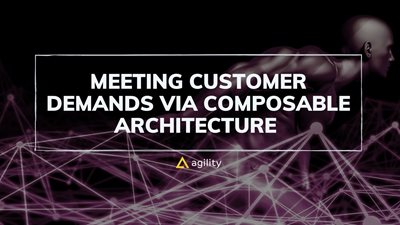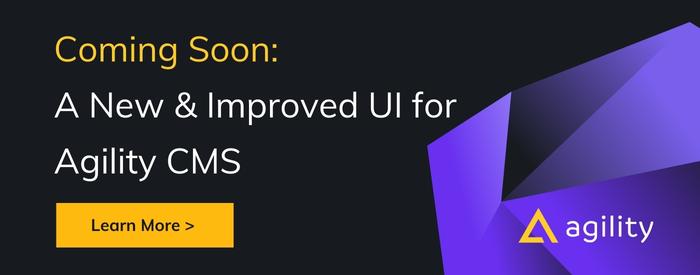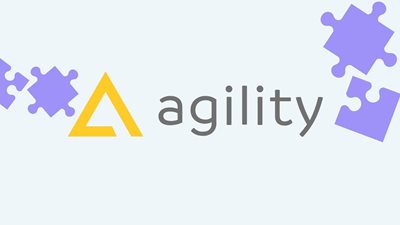Meeting customer demands via composable architecture
With digital consumers more demanding, developers need to implement composable architecture to keep up with such growing expectations.


One of the most well acknowledges realities is that digitalization has become more and more present in our lives. While the change was already happening, the pandemic seems to have accelerated the processes: people worldwide are adopting new technologies faster than ever before.
However, what is less straightforward to understand is how this transformation is causing a change in the consumers' behavior and demand.
This article will explore how digital consumers are becoming more and more demanding and how developers can keep up with such growing expectations. In particular, we'll see that composable architecture offers the most effective answer.
How digital consumers' demand has grown in recent years

While everything is going digital (communication, shopping, money transitions, and management), consumers' behavior is transforming too. We've all witnessed a considerable shift in what companies can provide digitally. The e-commerce market has grown to 757 billion euros in Europe alone by 2020 (10% more than in 2019).
But the same growth has been registered for digital communication in general. The 2022 report about the State of Digital communications redacted by no highlights how data usage in Europe has grown significantly (+53%) in 2022 and is projected to reach 454 GB/ month in 2023.
What consequences does this growth have for developers and anyone involved in the digital industry?
A mere decade ago, a company working in any sector could or could not have a website and thrive. Even pre-pandemic, companies didn't feel as much pressure to update their websites frequently. This has all changed.
Now, 1 in 4 visitors will abandon a website if it takes more than 4 seconds to load. A simple 1-second delay reduces customer satisfaction by 16%! Digital consumers' demand has grown and become more challenging to satisfy.
Today, any website, platform, app, or software needs to be high-performing. Developers must apply techniques and approaches to keep up with consumers' high and growing demand.
How to keep up with customer demands via composable architecture
How can we answer consumers' growing demand? One of the most effective answers is provided by composable architecture.
What is composable architecture?
Composable architecture replaces the old approach of developing customized enterprise suites to meet their customers' needs.
The term "composable" indicates something that can be broken into various modules which combine to form a whole. For IT solutions, composable architecture selects the best elements from all available services and platforms that can integrate with little effort. This way, the composable architecture allows enterprises to create and build faster and richer digital experiences for their customers with less effort and much more efficiency when compared to the traditional approach to enterprise software.
The new composable architecture approach is made possible by APIs, Application Programming Interface, allowing developers to connect the selected solutions.
What is API?
Composable architecture can be considered an API-based approach. If a composable IT is an ecosystem made of some individual systems and services working together, the developer's goal is to connect all the single pieces to build a cohesive platform that the user can experience. This is possible thanks to API.
API is what allows developers to make technology components communicate with each other. (Generally, SaaS solutions provide detailed documentation to help you integrate your APIs). It's a set of defined rules that explain how applications communicate with one another as it is an intermediary that processes data transfer between the systems.
This is how an API works:
- Request: an application initiates an API call to retrieve information. The API makes a call to the external program or web server.
- Response: The server sends a comeback with the requested information to the API.
- Data transfer: the API transfers data between the two applications.
Types of APIs
There are four main types of APIs:
● Open APIs. Also called Public APIs are open source app programming interfaces that developers can access with the HTTP protocol. They define API endpoints and request/response formats.
● Partner APIs. They are interfaces shared by digital business partners. Developers need to complete an onboarding process (with their credentials) to access this kind of API.
● Internal APIs. They are interfaces hidden from external users, and they are only available to people within the company. They intended to improve productivity and communication between development teams (always within the same company).
● Composite APIs. They combine multiple APIs to allow developers to access several endpoints with a single call. This type of API is critical in microservice architecture when performing a single task may require information from several resources.
Composable architecture and APIs

One of the most common composable architecture and API use examples is third-party payment modules. When you browse through an e-commerce website and you find the pay with PayPal button, that is the perfect example of what we've described so far.
The PayPal payment module is a single piece of application that works with the e-commerce platform through an API.
Types of composable architecture
When using APIs, there are two main types, both composable, of architectural approach: service-oriented architecture and microservices architecture.
SOA: Service-Oriented Architecture
In a service-oriented architecture, the different features are split up and made available as separate services within a network. There are various and single functional building blocks that can work together thanks to communication protocols and, of course, APIs.
Microservice architecture
With microservice architecture, an application is divided into smaller and independent components. At first glance, this approach might seem extremely complex: as we've mentioned, the single blocks are often so small that completing one task might require requesting information from several sources.
However, thanks to composite APIs, communication between the single pieces has become efficient, and developers can exploit microservice architecture's many advantages:
- working on single components independently from the others
- ease of maintaining testing
- updating the single components and more
How to get started with composable architecture
When you first approach composable architecture, there is one crucial resource that you, like all composable architecture developers, need: a place where you can provide yourself with the digital tools you need. In this regard, Agility CMS is the point of reference for many developers.
Agility CMS: Your Composable Enterprise Architecture Solution
Agility CMS has been swift in recognizing the changes in the market demand that we described above in this article. The team understood that Agility CMS had to respond to the difference with an update to its services and offerings: how could Agility CMS keep on helping developers provide consumers with what they need when consumers' needs have become so demanding?
Because the answer could only be found in composable architecture, Agility CMS decided to expand its composability offering and launched its new marketplace. Furthermore, to support the new marketplace applications, Agility CMS redeveloped its app framework to help those new applications.
With composable architecture as the primary approach and Agility CMS as a resource, developers are not only capable of responding to the current consumers' demand; this is what Agility itself calls a "future-proof" design. These resources are so versatile and flexible that they are meant to adapt and update as the consumers' demands change and keep changing.
Agility CMS and composable architecture are the definitive solutions because they are not absolute. After all, they are not a monolithic entity, and because they are components working together, they can be swapped, updated, added, removed, changed, and so on. They are a dynamic solution ready to evolve when the market demands it.
Should your Digital Business Move to Composable DPX?
If you have a digital business, you probably also have a website (if you don't have one, you should - if you aren't online these days, you nearly don't exist in the eyes of your customers). You are probably using a monolithic CMS if you have a website, even though you may not know it.
The most traditional and known example of a monolithic CMS is WordPress. With monolithic CMS, like WordPress, front-end, and back-end layers are coupled; this design works just fine to create one digital channel like a website, and it also makes the process of publishing content a simple process. When the project is simple, just like a website, developers also utilize monolithic CMS for their project as it can simplify many functions and make their workflow smoother and quicker.
However, developers are starting to look at a new approach that - on the one hand - can make the developing process even more agile and - on the other hand - allows them to create more complex digital platforms with the same ease. This new approach is composable architecture.
With composable DXP, front-end and back-end layers are decoupled. Connections, in this case, are made easier thanks to - as we've discussed above - the use of APIs. But where do you start?
Again, the answer is Agility CMS. Agility CMS allows you to choose the software tools you need and pre-built integrations to make composing DXP even more straightforward.
Why should you move to composable DPX?
We've mentioned that composable DPX can be considered a more powerful tool compared to monolithic CMS. Being composable architecture flexible and scalable, it is more straightforward with this approach to reach more advanced results.
Create an omnichannel digital experience
For example, you can connect multiple digital channels using APIs with composable architecture. It means that you can create an omnichannel digital experience for your customers.
Is that something customers are demanding? According to a study conducted by the website Blueshift - Insightful Multi-Channel Marketing Statistics[4] - "companies with strong multi-channel engagement yield approximately 6% more in annual revenue than those with weak multi-channel engagement", and "customers who have multi-channel experience spend approximately 13% more than those who don't".
Future-ready
What if the change we've described so far in digital consumers' behavior is only temporary? What if things go back to the way they were soon? What if they're going to change even further?
Whether the future holds, composable architecture can make developers unafraid of change. Whenever a change is required, developers can leverage their APIs to quickly connect to new digital channels, even those that will be available in the future and still aren't.
Ahead of the competition
Because, with composable architecture, you can respond to changes more quickly, you also have higher and higher chances of beating the competition. Being the first capable of offering a new service, for example, a new payment method, makes that business stand out from its competitors. If you are a developer, being able to offer your clients this level of adaptability would bring your professionalism to another level.
The final takeaway: Enterprise architecture with Composability
As people worldwide are becoming more familiar with technology and software applications, their demand is reaching levels never seen before. The role of developers is to allow businesses to keep up with this demand.
In this article, we've seen that the most effective answer is provided by composable architecture. We've also discussed if and why you, as a developer, should switch to composable architecture and the benefits it could lead to you and your clients.
Last but not least, for those who want to start with composable architecture, Agility CMS, with its new composability offers, is the most reliable resource available today.







